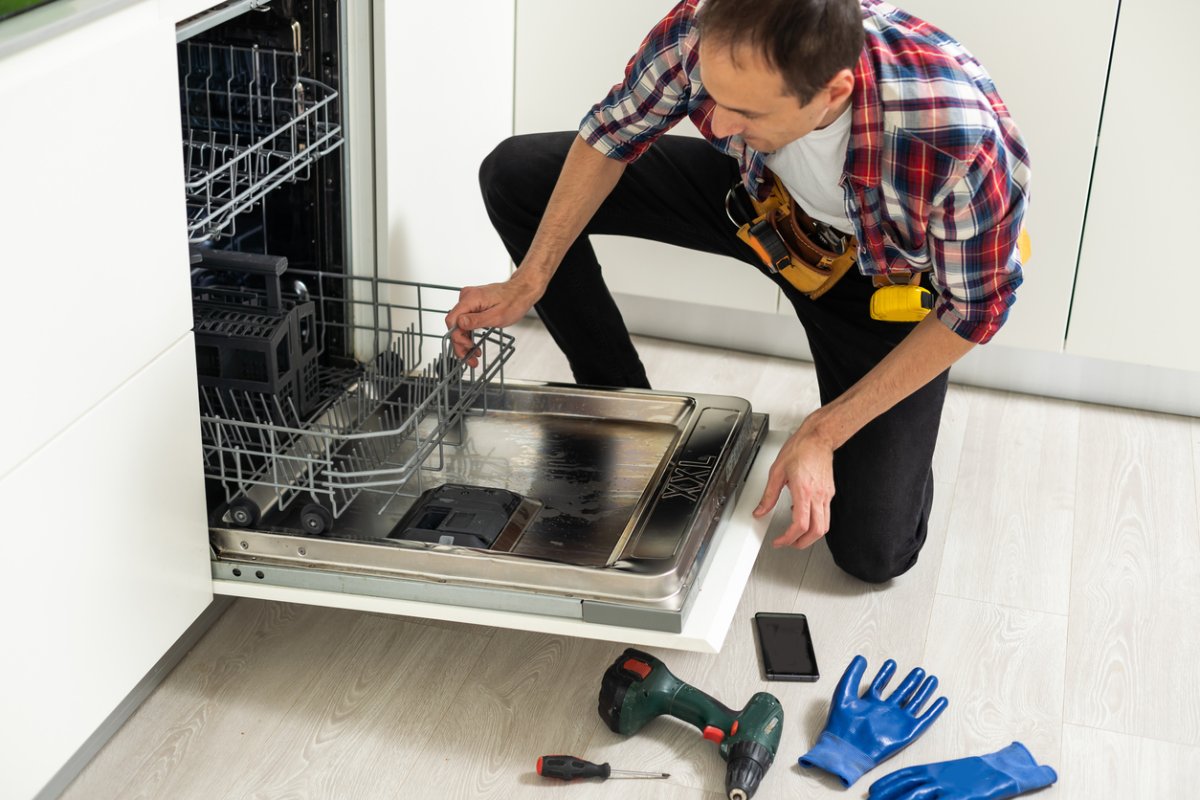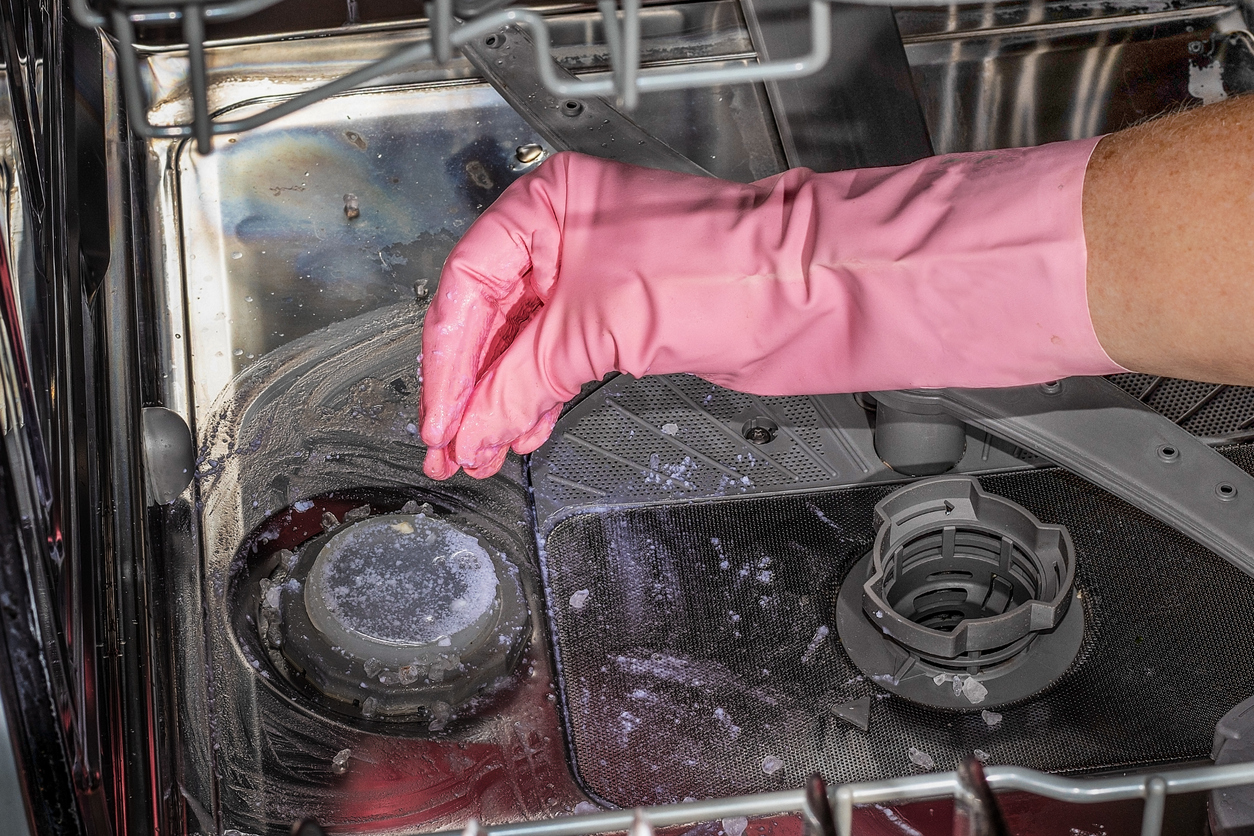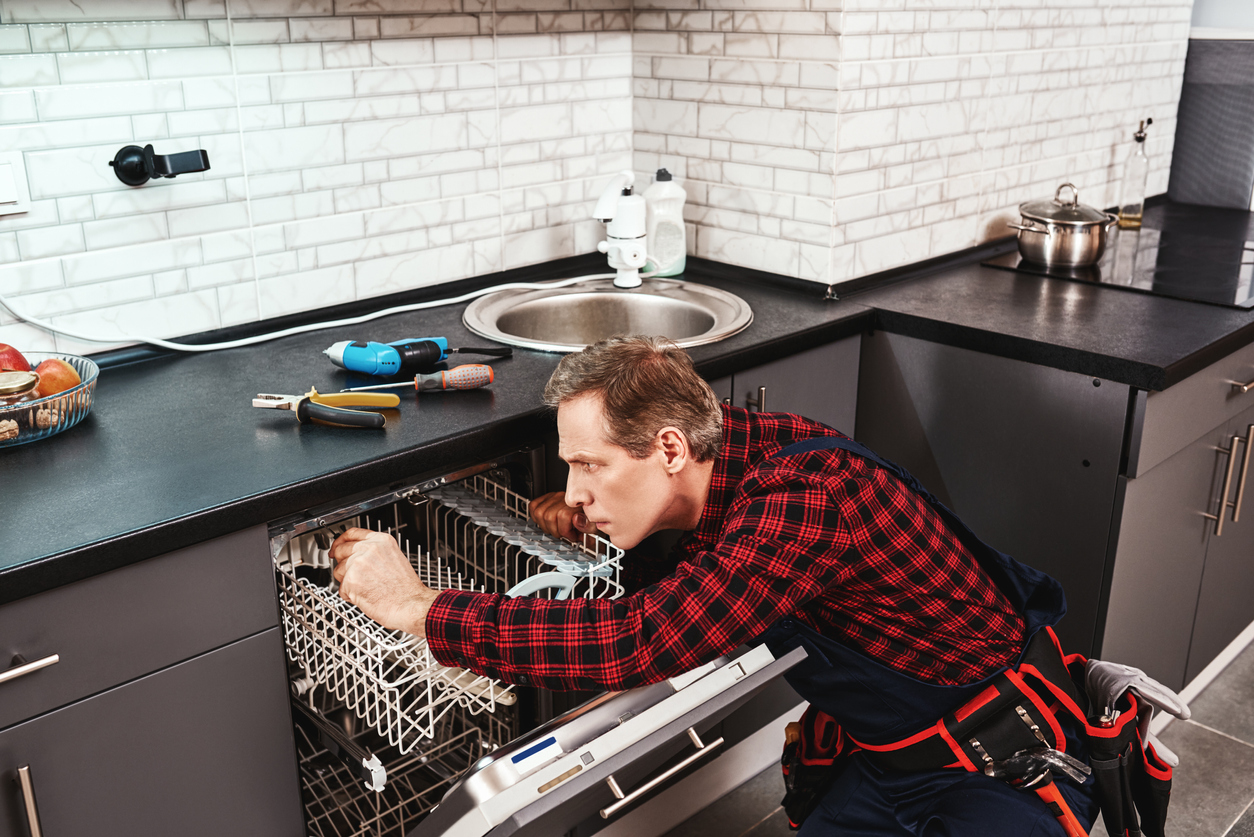

We may earn revenue from the products available on this page and participate in affiliate programs. Learn More ›
Q: I opened my dishwasher this morning and noticed a pool of water at the bottom. I didn’t run a cycle and haven’t seen any noticeable problems lately. Why is there water in the bottom of my dishwasher when it’s not in use?
A: A dishwasher filling with water when it’s not being used typically means that dishwasher repairs are imminent, but the severity of the issue may not be immediately obvious. The problem could be as simple as a minor drain clog or a kinked drain hose, or it could be something more extreme such as a leak in the water supply line. Whatever the case, water in the bottom of the dishwasher when it’s not in use is a problem that needs to be solved before it does more damage. It’s important to determine why the dishwasher is not draining in order to get the issue fixed.
There are many potential explanations for water in the bottom of a dishwasher when it’s not in use, but one of the simplest is backflow from a kinked drain hose.
While a very small amount of water under a dishwasher filter is normal, ideally there ought to be little to no water in a dishwasher tub unless it is mid-cycle. A dishwasher’s drain hose is responsible for carrying the wastewater from the dishwasher and directing it to the drainage system, so if the hose is kinked or obstructed in any way, it can disrupt the flow of water and cause drainage issues. If there is standing water in the dishwasher, it’s a good idea to check for a kinked drain hose first as this is one of the simplest problems to address. The drain hose is usually located under the sink or behind the dishwasher. If there is a kink or an unusual bend in the hose, it’s best to straighten it out before running the dishwasher again.
A broken check valve can allow water draining from the sink to leak into the dishwasher.
The check valve in a dishwasher’s drain system prevents water from flowing back into the dishwasher after it has been pumped out during the drain cycle. It also blocks water from the sink from entering the dishwasher. If the check valve is broken, stuck open, or not functioning correctly, it may fail to prevent wastewater from flowing back into the dishwasher. As a result, there will be water at the bottom of the dishwasher after the cycle is finished. If it seems like a broken check valve is the cause of the water pooling in the dishwasher, it’s a good idea to have it inspected and repaired by a qualified appliance technician. They can assess the check valve, identify any issues, and replace or repair it as needed to ensure proper drainage and prevent further damage to the dishwasher.
An inlet valve controls the flow of water into the dishwasher during the wash cycle, but if this part is broken it may drip continually even when the unit is turned off.
During a dishwasher cycle, the inlet valve opens to allow water to flow into the dishwasher’s tub. It’s controlled by the dishwasher’s electronic control board or timer, which regulates the amount and timing of water intake. If the inlet valve is damaged, worn out, or malfunctioning, it may not close completely when it’s supposed to, allowing excess water to enter the dishwasher (or alternatively, result in the dishwasher not getting water). With too much water entering the dishwasher, it can’t properly drain away during the cycle, leading to water pooling at the bottom. Just know that if this is the cause of the bottom of the dishwasher being full of water, it’s likely the valve is dripping throughout the day whether the appliance is being run or not. It may be necessary to replace the valve or have it repaired by an appliance specialist.

A leak in the water supply line can also cause clean water to pool in the dishwasher when it’s not in use.
Dishwashers are designed to fill with water at the beginning of a wash cycle and then use that water for cleaning dishes. If there’s a leak in the supply line, water will continue to flow into the dishwasher at all times, and the dishwasher may not be able to drain completely during the cycle. Since the dishwasher’s drain system may not be able to keep up with the constant inflow of water from the leak, water can accumulate at the bottom of the dishwasher. To identify this issue, homeowners can inspect the supply line, which is typically located behind the dishwasher. If there is evidence of a leak in the line such as holes or damage, it’s a good idea to shut off the water and contact a plumber to replace it. Once the repair has been made, it will be possible to see if the problem has been fixed by running the dishwasher and checking for water at the bottom of the unit after the cycle.
If water is not draining at the end of the dishwasher cycle, there is likely a clog in the drain line or a problem with the drain pump.
If water is not draining from the dishwasher immediately after a cycle, this could mean that there is a clog in the dishwasher’s drain line. A number of other signs can also indicate that the drain is clogged, including gurgling noises, foul odors, water backup in the sink, slow drainage, error codes, and dirty dishes. In some cases, it may actually be the drain pump that’s to blame. If a water pump in the dishwasher is working correctly, it will run audibly during the cycle, making a humming or buzzing noise near the bottom of the dishwasher, toward the front. Another way to make sure the drain pump is functioning is by touching the front of the dishwasher during a drain cycle and feeling the vibration from the pump expelling water. If there could be a clog in the drain line or the drain pump might not be working, the best bet is to call a professional to assess the issue.
Dishwasher clogs may be removed or ruled out by giving the unit a thorough cleaning.
While troubleshooting drainage issues in a dishwasher, it’s worth attempting to flush out minor clogs that could be to blame before calling for repairs. There are just a few steps involved in manually draining and unclogging a dishwasher:

- Clean out the dishwasher: Any standing water can be scooped out with a ladle, and the rest can be soaked up with a towel.
- Check for clogs: Once the water is gone, it will be easy to see the bottom of the dishwasher’s tub and identify any debris, food particles, or objects that could be clogging the drain.
- Clear out the filter: It’s normal for there to be a small amount of water in the dishwasher filter, but it’s a good idea to see if the filter is clogged with food. If it is, debris can be removed with a paper towel.
- Check the drain hose: The drain hose will be attached to the sink or garbage disposal, and once this connection is unscrewed any clogs can be removed using a long tube or plumber’s snake.
- Run a cycle: Once the hose is reattached, running a short cycle will reveal whether water is draining properly from the dishwasher.
If after running a short or long cycle there is still standing water or the dishwasher is still not draining, it may be time to call in the help of a licensed appliance repair person.
If water is still pooling in the bottom of the dishwasher, an appliance technician will be able to identify the problem.
If these common problems have been ruled out and there is still stagnant water in the dishwasher when it’s not in use, it may be best to look into local dishwasher repair services. Experienced technicians have the necessary training, tools, and expertise to diagnose the problem safely and effectively. Plus, calling an expert can save time, ensure the longevity of the appliance, and prevent potential safety hazards. Water pooling in a dishwasher is no small matter, especially when electrical components are involved. It’s also important to consider that a seemingly simple problem with the dishwasher might be a symptom of an underlying issue that only a trained technician can identify and address properly.
Dishwasher repairs are often best left to appliance repair professionals to ensure that no further damage is done to the unit.
Dishwashers are complex appliances with intricate components, including electrical, plumbing, and mechanical parts. This is why repairing them often requires specialized knowledge and tools that only an experienced appliance repair professional would have. Although it’s tempting to attempt DIY repairs, dishwashers have dangerous electrical components that could lead to electrical shock, especially if they are improperly exposed to water. The best appliance repair specialists will be able to not only properly diagnose the problem but also provide a path forward to fix it. If the problem is larger than a simple clogging issue, this is a job best left to the pros. Most dishwasher repairs cost somewhere between $50 and $600, and if the unit is beyond repair new dishwasher installation averages around $970.

A home warranty with appliance coverage can keep future dishwasher repair costs manageable.
Dishwashers typically last between 9 and 16 years, and most are likely to need some repairs during that span. A home warranty with appliance coverage can offer several benefits, the most important being financial protection and peace of mind when it comes to unexpected repair or replacement costs for appliances such as a dishwasher. The best home warranty companies like American Home Shield and AFC Home Club will likely have a plan with appliance coverage for everything from water pooling in the dishwasher to the dishwasher not turning on at all. Typically, homeowners only have to pay a flat fee for the service instead of paying for labor, parts, and house calls. Home warranty companies also have a network of prescreened service providers and contractors, saving homeowners the trouble of searching for a reliable technician when things go haywire.
